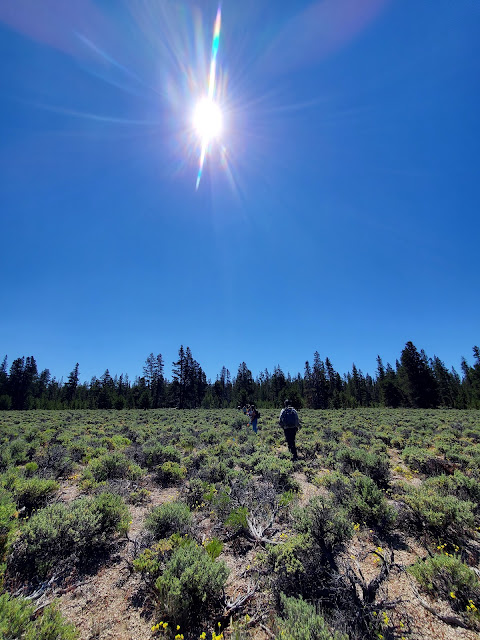8th Day - Desert Fern Surveying in La Pine
Thursday, July 14th, 2022
Started the morning off waking up into a cold crisp morning here at the Cow Meadows Campground here in Deschutes. Mosquitos are terrible here, first thing as soon as I walked out they were eating me alive.
Had a fast breakfast and got on the road to head over to East of La Pina area where there is a lot of fast fuel grass, pumice stone, sand textured ground, numerous lodgepole trees surrounding us. We drove about an 1 into the forested area to the same environmental area explained previously except there looked to have been a meadow in this area where we would find ourselves surveying the area alike doing fire gridding is easiest I can compare it to in my own experience.
Providing us with more information on this field day was Marlow Fisher, who works with the Deschutes Forest Service as their Botanist, she graduated from Oregon State University. The inspiring side of her I took away was that she got through her undergrad at IU and one of her last classes is what took her into her career path she never thought she’d go into, which is botany. Sarah Garbin was the next person who was on-site who supervises the Natural Resources Staff temporarily through the Deschutes Park Service but her main title and expertise is the Region 6 Seed Extractory. I find that so cool because she could be a key source in restoration of plant species in heavily disturbed areas and reproduction that could be endangered to bring back and carefully handling the seeds itself. An AmeriCorps Intern, Anthony Lazuna was there to help with the surveying and where he was needed while he was assisting there work. He was currently still attending school at OSU Cascades as an undergraduate and was still searching what he would be doing his master’s degree on.
After our introductions we immediately got to work where the 13 of us spread out in a fire gridding fashion spacing another 10-15 feet apart to flag a particular desert fern called Pumice Moon Wart, also called “BOPU” for short abbreviation in its scientific name. This grows above ground about 1-2 inches in pumice soil above that had been layered there from the Newbury Crater volcanic eruption. I also took a few of those pumice stones so I could do a cold creek pedicure on my feet and maybe someone’s elbows, lol jk. This area was chosen for this surveying work due to the absence there has been on the plant possible due to climate change, the lodgepole being the dominant tree there. When I was a forest technician with Forestry Pre-sales with Yakama Nation, I had learned that Lodgepole was considered a weed tree that took a lot of nutrients and moisture from other trees so this could be a possibility why there is less of the fern in the area. This is my thought due to the plant being a fern and most fern families like to be around water, they are usually good indicators for water sources and moisture.
Data we know of is there was thinning done on the lodgepole and a prescribed burn in the area 3 years prior. Last year there was a survey done on 1500 square feet, where 50% of the area was covered and a count of 800 BOPU’s were flagged for presence. We did a full sweep of the remaining area flagging it off by gridding and then did a sweep back to check over any unaccounted for. Collected the flags and were able to account for 753 BOPU’s. So there definitely is a presence of the BOPU’s there but a question I think that came to mind on this project is, “Why are they disappearing? Did the BOPU seem to have a thriving affect after the burn versus before? Is the moisture content something we need to look at more? Or is the lodgepole completely sucking all the nutrients out of the ground and moisture content?” These are only some of the questions I’m asking myself due to it being a meadow like environment, also thinking there may have been water present at one time and it depleted into the center making the fern thrive there more than the center. Hence, maybe the root system of BOPU is so long (1ft) on the edges trying to reach moisture and maybe not so much in the center since that is last of where the water dried up. Ok, ok, last question… “Is the pumice soil having an affect like sand where it is more draining and sunlight and heat is able to pierce it and dry up the moisture in the soil where the plant could thrive? Guess, its just the scientist in the making for me that makes me ask so many questions. Ok, lets get to the rest of the day, sorry for the book, I was freewriting and got carried away with my observations and information.
Next, stop was showers at another
campground closer to ours, while everyone showered at the site, I decided that
I would rather jump in the lake and had 1 other person who thought this was a
good idea and 2 others who wish they would’ve joined. The water was awesome,
especially after a hard day in the sun and walking. Then go to camp, ate some really good alfredo
one of the mentors made and went straight back to science observing and sharing
data on our water quality, bacteria and fungal growth samples. Now we are writing
our blogs. Hope you enjoyed this
loooooooong blog if you made it to here. Below I will be sharing the pics of
the day I took.
Goodnight…








Comments
Post a Comment